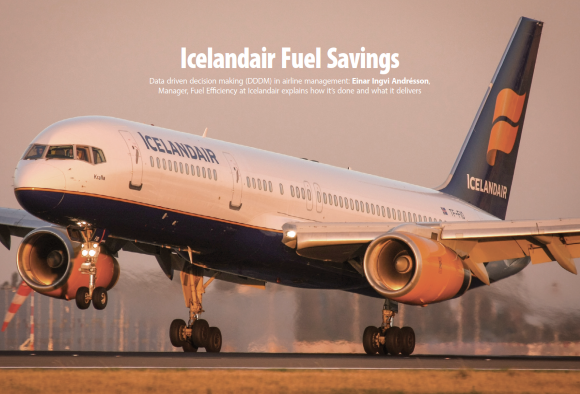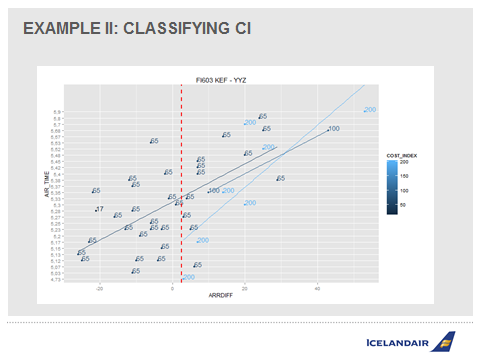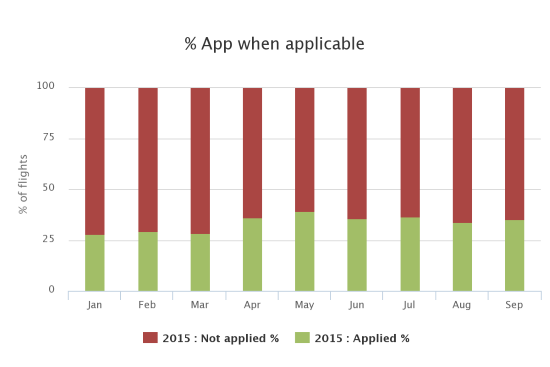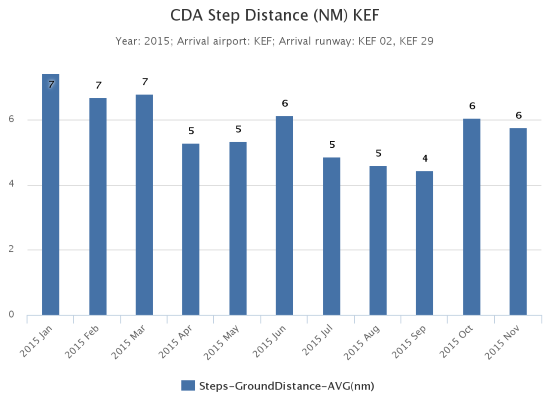Case Study: Icelandair Fuel Savings
Author: Einar Ingvi Andrésson, Manager, Fuel Efficiency, Icelandair
Subscribe
Icelandair Airline Fuel Savings Case Study
Data driven decision making (DDDM) in airline management: Einar Ingvi Andrésson, Manager, Fuel Efficiency at Icelandair explains how it’s done and what it delivers
Before diving into our experience at Icelandair with data driven decision making (DDDM) and, in particular, applying OpenAirline’s SkyBreathe® to our fuel management actions, it will be useful to explain a little about Icelandair’s business. For nearly 80 years, Icelandair has been operating in an arctic environment, so we’re well used to facing challenges. In 2014, Aviation Magazine ranked Icelandair as the fourth best run airline in Europe and it was the first non LCC (low-cost carrier) to earn that recognition. The fleet is largely Boeing 757 (28 aircraft) plus one Boeing 767 with another 767 scheduled to join the fleet later in 2016. The airline operates from a single hub in Keflavik serving North America and Europe with a network that has tripled in size since 2009. In 2014, fuel uplift was 60 million US gallons. The question that we had to ask ourselves, and which lead to the project in this case study, was how do we prioritize our business… which way should we go? And how do we best utilize our time and resources?
Priority number one is always safety: in this respect, many pilots regard Iceland as essentially an aircraft carrier in the middle of the North Atlantic where you have to contend with cross-winds, icing and occasional volcanoes. There are also the ‘low hanging fruits’ such as EOTI (engine out taxi in) to consider: should they be tackled at the outset or is there something else more urgent..? trajectory optimization, maintenance, ground operations. It’s important to think about whether to do IT related things in-house or to outsource; with the former course it will be necessary to deviate from the core business (running an airline) to be a full IT house with a huge software development team and the rest of what an IT business demands? All airlines have to decide whether to build an full in-house IT capability, outsource everything or look for a ‘sweet spot’ between those two extremes.
In this, we found a tool, SkyBreathe® from OpenAirlines, which actually helps us address some of these questions of how best to prioritize our thinking, activity and time.
THE IT AND AIRLINE WORLD WE LIVE IN
Let’s first look at another industry, one that is not aviation but whose products are key to commercial aviation; the oil industry. Back in September 2015, a headline in Fortune magazine read, “Big oil turns to big data as oil prices plummet”. It referred to an oil industry that has been cutting jobs by tens of thousands and simultaneously pumping billions of US dollars into big data and big data analytics in what is basically an exercise of risk management. Airlines face a similar conundrum.
Deciding what data is needed
One way to go is to collect all the data that can be collected; but then, in the resulting ocean of data, we’ll definitely need a bigger boat; especially as data volumes are predicted to grow exponentially in the future. So, is that really efficient? A data analyst will spend most of their time pruning, filtering and cleansing data to generate actionable information out of the useful data that is available.
Computation capabilities (computing power) in operations research have also been growing exponentially in recent years and will continue to do so: why then do optimization run times stay the same? It’s because of the amount of data (also growing exponentially – see above) being fed to the optimization algorithms. In that context, airlines need to ask and answer questions such as, ‘Do we need fuel flow per engine every four seconds during cruise?’ That might be necessary doing take-off but is that also true of the cruise? Or, ‘Do we need time-stamped GPS latitude/longitude/altitude every second for trajectory optimization during the whole duration of the flight?’ In some, more complicated, segments of the profile such as descent and climb, that might be necessary but not every second or even every four seconds during cruise. The higher computation capability with higher data resolution offers an opportunity to move closer to the optimum but, we need to consider, at what costs? Do airlines want to invest in such a powerful IT computing infrastructure or would they do better to outsource it to experts and concentrate on the core business of running an airline. What we can all agree on is that, when data is used properly the results can be quite staggering.
Further complicating the issue, in the airline sector, a lot of concepts have been turned into buzzwords. Consider ‘big data’; where does the definition start or end? Also, what might be ‘big data’ for one organization might not necessarily be big data for another… in Icelandair we have 29 aircraft whereas other airlines have 300 or 400 and a few fly over 1,000 aircraft. Different airlines have different needs. What about ‘cloud’? The offer often includes parallel programming, data storage off-site, using gigaflops of computing power to do ‘cloud computing’. But there’s a lot that airlines can do before they need to do cloud computing… compressing data; pruning data; sub-setting – all these can be done. One of the newer job titles is itself a ‘buzzword’; that of Data Scientist. Data Scientists can be drawn from a number of backgrounds from applied mathematics, statistics or computer science to engineering; but an airline data scientist needs an understanding of all those things with the proficiency to deal with lots of data and to make actionable information out of the data; and that’s the key aspect.

Figure 1
It’s not only about the data (figure 1), it’s also about the insight gleaned from that data, what we do with the data that we have, and decisions made by the senior management team to create a platform of where and how we divide our decision making which, in turn, creates value.
Making time to dig into the data
It’s important to dig deep; digging deep is a key requirement because, coming to the core topic of this case study, it is airlines that need to drive fuel efficiency further, albeit working in cooperation with vendors, ANSPs (air navigation service providers) and others. In reality, stand-alone, off-the-shelf, third party software does not automatically reflect operational needs and networks for airlines; it has to be adjusted. IT products can be split into two categories; those with an open budget and fixed time frame and those who have a limited budget but a wider time frame. Users have to become vertically integrated with their vendors to have them work with the user. In Icelandair we’ve outsourced our day-to-day processes so that we can allocate our time for the specifics that apply to our network. Best practices are now dealt with by a third party, Open Airlines with the SkyBreathe® software and consultancy. Icelandair uses the time freed by that outsourcing to dig deep into the data and further analyze our network – we’re always looking for the missing piece in the puzzle (figure. 2).

Figure 2
EXAMPLES
The Angry Dad
I’m going to start this section with the ‘Angry Dad’ story… bear with me; all will become clear. It’s about Target (a huge discount retailer in the United States) that is very adept at using data and predictive analytics. Based on a customer’s purchases, Target can identify products and correlate that information to a lot of needs that people have which information should, in turn, lead to better marketing and advertising. This case refers to a Dad who became furious with Target and ended up asking them why they were sending him and his teenage daughter pregnancy related advertisements and offers. In fact, Target knew before the Dad that the teenage girl was pregnant and were even able to tie down with a high degree of correlation where in the pregnancy term she was plus, based on the items she was buying, roughly the gender. It illustrates a very good example of data mining and machine learning. Applying what is learned from the data and learned about it.
A good example in the airline industry is the fuel market and the performance degradation of an aircraft; we need to use and learn the history of each aircraft based on its various attributes and different sources of data, and we want to apply that knowledge to further enhance the accuracy of flight plans.
Classifying Cost Index
Figure 3
This (Figure 3 above) is a good example of classification data mining and machine learning. At Icelandair, we were data mining our cost index of the network and for constrained turnaround times. This example is for Toronto where we have a short turnaround time. Dispatchers relying on their experience started to increase the cost index of that route, their logic being that not only is there a short turnaround time but also the catering and the baggage handler start late on the aircraft, in Toronto. There is one flight 20 minutes ahead of schedule on cost index 17 (left side of chart, just below half-way down) which was, at the time, ECON (economy cost index): all the others are 65s and the red dotted line is the average arrival time – it can be seen that we were landing a lot of aircraft ahead of schedule. Each cost index 65 represented $800 more in fuel than the ECON flights. Yet that ECON flight should not have even been there twenty minutes early because the aircraft just sat on the ground until the ground handling agent started later – a ground handling issue. This is where tactical and strategic decisions have to be separated. Dispatchers and pilots see this sort of situation unfold every day but they do not have the benefit of hindsight when deciding what to do.
Engine Out Taxi In
At Icelandair, we’re not particularly good at this because we had a little mix up in our SOPs (standard operating procedures) stipulating that an aircraft cannot cross an active runway with one engine taxiing. As a result, it looks as if we are slipping on this factor (figure 4 below) but the chart only shows one side of the story.
Icelandair EOTI performance
Figure 4
The chart shows the application rate but not the quality of the application. In fact, when it came to the savings, we were actually improving with these performance results. What this tells us is that how the data is presented in a company is just as important as the data infrastructure and how it is mined. It’s very important to think carefully about the presentation of data as information.
CDA (constant descent approach) step segments in KEF (Keflavik airport)
Looking at the figure 5 below, readers will observe a spike in June.
Figure 5
The difference here is that we’re able to perform CDAs from the top of the descent at Keflavik, which means that we have a really high yield of fuel savings to gain. The reason for the spike was partly a spike in traffic as tourists visited Iceland for the Summer Solstice but, even more important was the fact that we were training new pilots. As always, safety is the first consideration and the new pilots were performing their first landings so were still learning the new methods. This is the business knowledge of which a data scientist at an airline has to be aware when looking at data. So we need a combination of information about what has happened and knowledge about the context in which it took place.
Further knowledge is needed such as the number of steps in a normal descent and what are the step altitudes because there are fewer penalties if steps are placed earlier in the descent. So, even though figure 5 looks like a really simple graph, it actually raises more questions.
And what if we put seasonal trends or event driven forecasts into the mix? The first three months reflect the fact of winter weather plus it can be seen that in October and November the same factor applies, hence the higher results.
THE REWARDS FOR OUR EFFORTS
Icelandair has enjoyed both direct and indirect benefits from the new system and processes. Of course, we are always looking for further fuel savings and SkyBreathe has helped a lot in that quest. It enables us to identify, track and monitor progress which, in turn, helps the decision making process as to what projects we should focus on and emphasise at the appropriate time. Of course, sometimes, you’ll hit a wall and if, for example, you’re working with ideas, then you have to be flexible and move on to the next. It’s important to always be adaptive and flexible… to always maintain progress.
Force projection
As mentioned above, the day-to-day business which was outsourced to OpenAirlines in the SkyBreathe® program means that we were able to leverage available resources to further delve into our networks and dig deeper. This has enabled us to push our IT supplier and ourselves because now we have the time to do what we want to do to support the core business… analysis instead of writing reports or undertaking mundane processes that were not previously automated.
RECAP
Tactical versus strategic decisions
It’s the dispatchers and pilots who have to make the tactical decisions; so we want to give them the best information on which to base those decisions; information such as taxi times, weather, statistical enroute time. As has also been referred to above, they have to work without the benefit of 20/20 hindsight which makes post-Ops analytics the platform for strategic decisions. This makes it abundantly clear that optimization and driving efficiency is a pan-organizational effort.
In all of this, Icelandair’s fuel efficiency team plays a key role in maintaining that effort, supplying relevant information to the parties who need it and when it’s needed plus coordinating optimization efforts in the best interests of the airline.
At Icelandair, we tried Scrum and a consulting company we worked with a few years ago advocated Prince2 (projects in controlled environments version 2) project management methodology which is designed for government agencies but not suitable for the culture in which Icelandair operates. We now use a hybrid project/process management methodology based on those used by an orthopedic products company and a food processing company.
Notwithstanding this article, I cannot tell you what to do. Each airline will need to tailor its data streams to fit the requirements of their business. The first step is to personalize the data streams, get relevant data for the relevant time and reduce the noise because too much irrelevant data can be distracting. The conundrum here is that we also need to dig deeper. And it’s important to prioritize what has to be done based on the constraints impacting your operation. Finally, we should always ask questions; the most powerful question is ‘why?’… Be the Devil’s advocate and use whatever best suits your needs and those of your organization.
Contributor’s Details
 Einar Ingvi Andrésson
Einar Ingvi Andrésson
Einar has been in commercial aviation for nearly four years having previously worked in IT. He is now manager of fuel efficiency at Icelandair and, as part of that prime role, Einar oversees analysis and development projects within Icelandair Flight Operations. Einar holds an M.Sc. in Decision Engineering (a hybrid discipline of IT, computer science and applied mathematics) where he majored in Applied Mathematics.

Icelandair
Icelandair is the main airline of Iceland, headquartered at Reykjavík Airport in Reykjavík. It is part of the Icelandair Group and, during the summer of 2015, operated scheduled services to 39 cities in 16 countries on both sides of the Atlantic Ocean out of its hub at Keflavík International Airport. The geographical position of Iceland allows one-stop transatlantic flights, which are one pillar of the airline’s business strategy, along with traffic to and from the country.

OpenAirlines
OpenAirlines is a global software developer and vendor serving the airline industry. In particular, the company focuses on efficiency and cost effectiveness through fuel efficiency and the reduction of CO2 emissions. The main product is SkyBreathe®, a fuel saving and CO2 reducing software. It was a very long time in the making with six years of a participation in the European Research Program ‘Clean Sky’.







 Einar Ingvi Andrésson
Einar Ingvi Andrésson


To post a comment, please login or subscribe.